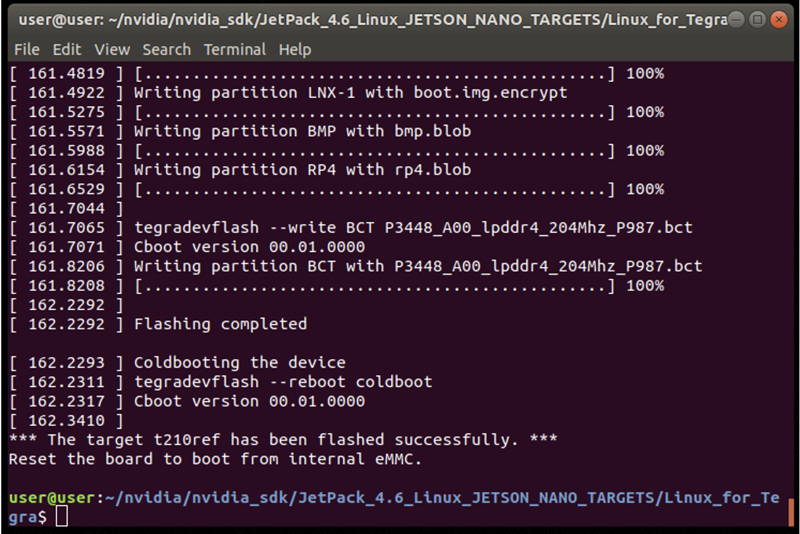JetPack-4.6 Installation, Root File-System Transfer and OpenCV Install (DSBOX-N2)
ENVIRONMENT
Hardware 1: DSBOX-N2
Hardware 2: Corsair Gaming PC
OS 2: Ubuntu 18.04.5 LTS
Language: Bash
In this tutorial, we will install JetPack-4.6 for DSBOX-N2. First, we will include our Image and DTB file in Jetson OS image. Then, we will install the Jetson OS into the DSBOX-N2. Afterwards, we will transfer the root file-system. Finally, we will install the Jetson SDK components and install the custom OpenCV package into it.
Attention: If you want to transfer the root file-system to an external drive, please format it before starting this blog post.
Including the Image and DTB file in Jetson OS Image
Open the NVIDIA SDK Manager. Select “JetPack 4.6” for Target Operating System and “Jetson Nano modules” for Target Hardware. (The “Host Machine” components are not required) Then continue to Step 2.

Choose only “Jetson OS”, accept the terms & conditions and continue to Step 3.

The SDK Manager will ask the username’s password. Fill it and continue.

After the Jetson OS has created, the SDK Manager asks the Jetson module’s flashing style. Just skip it and exit from the SDK Manager.


Open the target HW image folder. (${HOME}/nvidia/nvidia_sdk/JetPack_4.6_Linux_JETSON_NANO_TARGETS/Linux_for_Tegra/)

Download the BSP files from GitHub link and extract it.

Copy the Image file to the “kernel” folder.

Then copy the DTB file into the “kernel/dtb” folder.
Attention: If you use one of the previous DSBOARD-NX2 (rev-1.0, 1.1 & 1.21) carrier boards, please use the DTB file from the “without_fan” folder.

Return to the “Linux_for_Tegra” folder and open a Terminal.

To begin with, create the system image again with this command:
$ sudo ./flash.sh --no-flash jetson-nano-emmc mmcblk0p1

A few seconds later ...

Jetson OS Installation
Connect the recovery USB (between installer PC & DSBOX-N2's recovery USB) and power connection of your DSBOX-N2.
While the DSBOX-N2's power connector plugged in,
• press power button then wait for boot led lights up.
• press reset & recovery buttons together
• release reset button
• release the recovery button after 3 seconds later. This will set it to Recovery mode.
Then type lsusb and check the device connected in Recovery mode (0955:7f21 NVidia Corp.)

Flash the Jetson OS with this script:
$ sudo ./flash.sh -r jetson-nano-emmc mmcblk0p1

A few seconds later …

At the end of the script, the device will reboot. Configure your Ubuntu installation progress from the DSBOX-N2 (language, keyboard type, location, username & password etc.).

To avoid kernel update with "apt upgrade" or "apt-get upgrade" commands, please follow this guide on the Jetson module.
Root File-System Transfer
Jetson SDK Components Installation
Delete LibreOffice & ThunderBird packages (if you don’t need) and remove the unnecessary packages to increase the free space. To do this type these commands to the DSBOX-N2 side:
$ sudo apt remove -y libreoffice* thunderbird*
$ sudo apt autoremove -y
$ sudo apt clean
Connect the DSBOX-N2 to the Ethernet or connect its Recovery USB to the Host PC. Then open the NVIDIA SDK Manager. Select “JetPack 4.6” for Target Operating System and “Jetson Nano modules” for Target Hardware. (The “Host Machine” components are not required) Then continue to Step 2.

Choose only “Jetson SDK Components”, accept the terms & conditions and continue to Step 3.

The SDK Manager will ask the username’s password. Fill it and continue.

Type the IP address, username and password of DSBOX-N2 and Install the SDK Components.

At the end of the installation, the DSBOX-N2 becomes ready. If you want to install OpenCV package with CUDA support, compiled by us, you can continue with the steps below.
Custom OpenCV Installation
In JetPack’s current OpenCV build, it compiled without CUDA libraries and some another packages. In this package, we will install the OpenCV-4.4.0 package built with CUDA libraries.
Download the OpenCV package from here, extract the archive and open a terminal into its folder.
Type this command below:
$ sudo ./opencv_install.sh
This script file will remove the default OpenCV packages (if you have another OpenCV libraries installed into /usr/local, you may want to remove them before), install required libraries and install the custom OpenCV package.
After installation ended, you can test the OpenCV Python package with tracker sample:
$ python3 opencv_python3_tracker.py
Thank you for reading our blog post.


